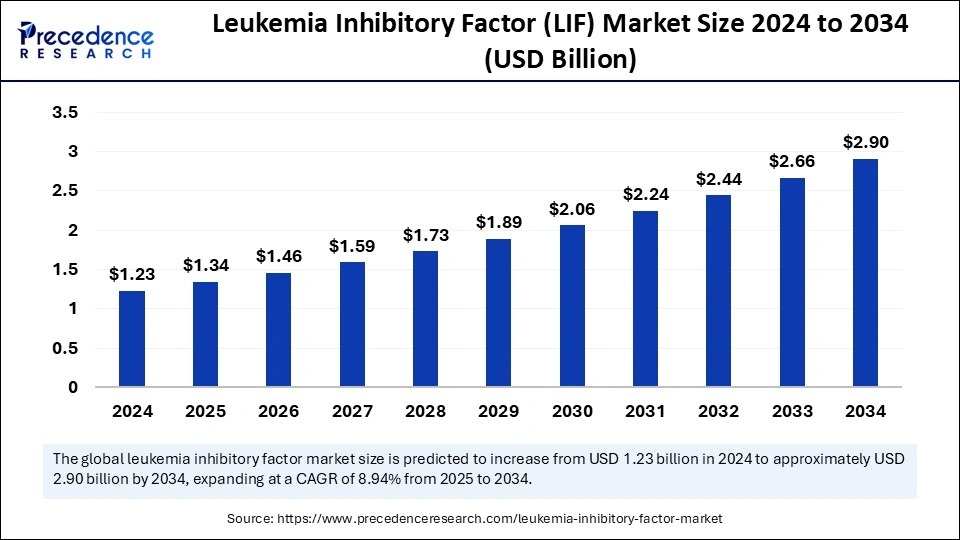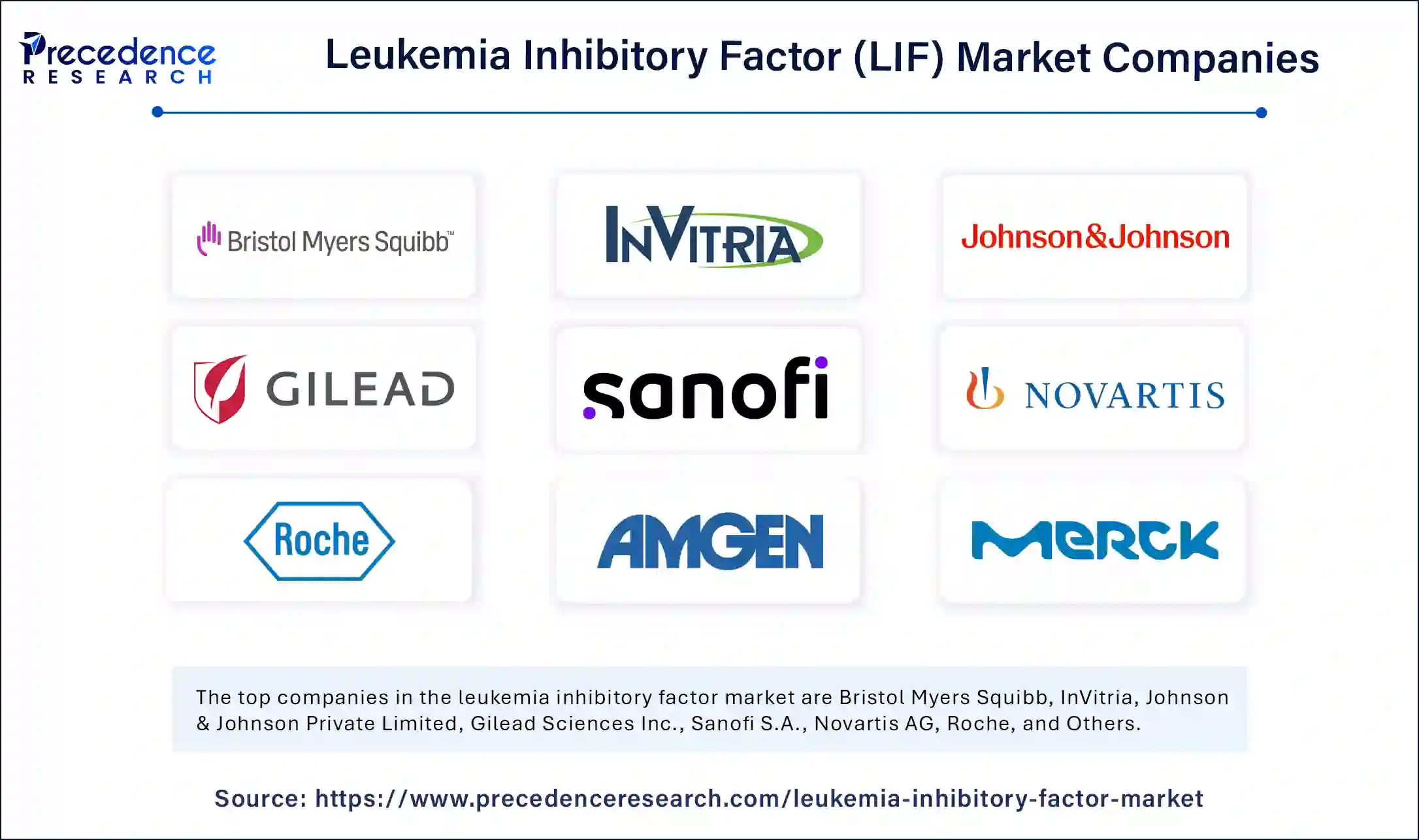Leukemia Inhibitory Factor (LIF) Market Size to Surge USD 2.90 Bn by 2034
Leukemia Inhibitory Factor (LIF) Market Size and Growth 2025 to 2034
The global leukemia inhibitory factor (LIF) market size is estimated to worth around USD 2.90 billion by 2034 increasing from USD 1.23 billion in 2024, with a CAGR of 8.94%.

Get a Free Sample Copy of the Report@ https://www.precedenceresearch.com/sample/5822
Leukemia Inhibitory Factor (LIF) Market Key Points
-
North America maintained its dominant position in 2024, with 41% of the global market.
-
Asia Pacific presents significant growth potential over the forecast period.
-
Europe continues to grow, driven by technological and research advancements.
-
Recombinant LIF products led the market in 2024 across product types.
-
LIF antibodies are expected to show strong performance in the years ahead.
-
Cancer treatment applications held the largest market share in 2024.
-
The stem cell research segment is on track to record the fastest growth rate.
-
Hospitals were the top end user segment in 2024.
-
Rapid expansion is forecasted for research institutes through 2034.
Role of AI in Leukemia Inhibitory Factor (LIF)
Artificial Intelligence (AI) is playing an increasingly vital role in advancing the understanding and application of Leukemia Inhibitory Factor (LIF) in biomedical research and therapeutic development. One of the key contributions of AI lies in accelerating the discovery of novel functions and interactions of LIF at the molecular level.
By leveraging machine learning algorithms and deep learning models, researchers can analyze vast datasets such as gene expression profiles, protein interactions, and signaling pathways to identify LIF-related mechanisms in various conditions, including cancer, neurodegenerative diseases, and stem cell biology.
Furthermore, AI-powered tools are enhancing drug discovery and development processes involving LIF by predicting drug-ligand interactions, simulating biological responses, and optimizing candidate molecules. In stem cell research, AI is being used to monitor and predict the impact of LIF on stem cell maintenance and differentiation in real time.
It also facilitates the identification of biomarkers and potential therapeutic targets by integrating genomic and proteomic data. Overall, AI enables faster, more accurate, and cost-effective research, positioning it as a transformative force in unlocking the full therapeutic potential of LIF in precision medicine.
What is Leukemia Inhibitory Factor (LIF)?
Leukemia Inhibitory Factor (LIF) is a multifunctional cytokine belonging to the interleukin-6 (IL-6) family. It was initially discovered for its ability to induce the differentiation of myeloid leukemia cells, hence the name. However, its biological role extends far beyond leukemia, as it is involved in a wide array of physiological and pathological processes, including cell proliferation, differentiation, survival, immune response, inflammation, reproduction, and neural development.
Key Biological Functions of LIF
-
Stem Cell Maintenance
LIF is crucial in maintaining the pluripotency of embryonic stem cells, especially in mouse models. It prevents stem cells from differentiating, making it an essential tool in stem cell culture and regenerative medicine research. -
Neural Development and Repair
LIF plays an important role in the development and survival of neurons. It is also upregulated in response to injury, aiding in neuroprotection and regeneration. -
Immune Modulation
LIF is involved in modulating immune responses, including suppressing certain pro-inflammatory pathways. It helps regulate the balance between pro- and anti-inflammatory cytokines, which is important in autoimmune and inflammatory diseases. -
Cancer
While LIF was initially studied for its effect on leukemia, later studies revealed its dual role in cancer. In some cases, LIF acts as a tumor suppressor, while in others, it promotes tumor growth, metastasis, and drug resistance, particularly in breast, pancreatic, and colorectal cancers. -
Reproductive Biology
LIF is essential for embryo implantation in the uterus. It plays a critical role in establishing pregnancy, and its deficiency has been associated with infertility. -
Bone and Muscle Development
LIF influences osteogenesis (bone formation) and myogenesis (muscle development), making it a subject of interest in musculoskeletal research.
Clinical and Research Applications
-
Stem Cell Culture: Widely used to maintain embryonic stem cells in an undifferentiated state.
-
Cancer Therapy: A potential target for therapies, especially in tumors where LIF is overexpressed.
-
Fertility Treatments: Investigated for its role in improving implantation success.
-
Neurodegenerative Disease Research: Studied for its neuroprotective effects in diseases like multiple sclerosis and Alzheimer’s.
-
Autoimmune Disease Modulation: Potential use in regulating immune responses in autoimmune conditions.
Leukemia Inhibitory Factor (LIF) Market Overview
The Leukemia Inhibitory Factor (LIF) market has witnessed steady growth over the years, owing to its essential role in stem cell biology and its emerging applications in regenerative medicine, cancer research, and neurobiology. LIF is recognized for maintaining the pluripotency of stem cells, particularly in in vitro culture, which makes it an important tool for cell-based therapies and research.
Furthermore, its potential in treating a variety of diseases, from cancer to neurodegenerative disorders, has garnered increasing attention from both academic and commercial sectors. The market for LIF-related therapies and products continues to expand as more biotech firms and research institutions explore its therapeutic potential.
Leukemia Inhibitory Factor (LIF) Market Scope
| Report Coverage | Details |
| Market Size by 2034 | USD 2.90 Billion |
| Market Size in 2025 | USD 1.34 Billion |
| Market Size in 2024 | USD 1.23 Billion |
| Market Growth Rate from 2025 to 2034 | CAGR of 8.94% |
| Dominating Region | North America |
| Fastest Growing Region | Asia Pacific |
| Base Year | 2024 |
| Forecast Period | 2025 to 2034 |
| Segments Covered | Product Type, Application, End-User, and Regions. |
| Regions Covered | North America, Europe, Asia-Pacific, Latin America, and Middle East & Africa |
Leukemia Inhibitory Factor (LIF) Market Dynamics
Market Drivers
The primary drivers of the LIF market include the growing demand for personalized medicine and the rising prevalence of chronic diseases like cancer and neurodegenerative conditions. LIF’s involvement in maintaining stem cell pluripotency has made it invaluable in regenerative medicine and stem cell research, two rapidly advancing fields.
Additionally, the increasing investment in biotech research and development, particularly in oncology and fertility treatments, has further fueled the growth of the market. The development of LIF-based therapies, including its use in cell differentiation, immune modulation, and cancer treatment, is driving substantial interest from pharmaceutical companies and research organizations worldwide.
Opportunities
There are several opportunities in the LIF market, especially as more is understood about its biological mechanisms. One of the primary opportunities lies in the expansion of stem cell-based therapies, where LIF plays a key role in maintaining stem cell growth and differentiation. LIF’s potential to influence cancer stem cells also opens doors to targeted cancer therapies that could complement existing treatments. Another significant opportunity is in fertility and reproductive medicine, where LIF is known to assist in embryo implantation.
Furthermore, LIF’s anti-inflammatory properties could be harnessed in the development of therapies for autoimmune and inflammatory diseases. As more clinical trials and research studies are conducted, new applications for LIF-based treatments may emerge, presenting further market opportunities.
Challenges
Despite its potential, the LIF market faces several challenges that could hinder its growth. One of the primary concerns is the complex and often contradictory role of LIF in various biological processes, particularly in cancer. While LIF can act as a tumor suppressor, it has also been found to promote tumor growth and metastasis in certain contexts, making its therapeutic application complicated.
Additionally, the high cost of research, the need for specialized handling, and the complex production processes of LIF-related products pose significant barriers. Regulatory hurdles surrounding the approval of LIF-based therapies, particularly those involving stem cells, also present challenges to market expansion. Moreover, the ethical concerns regarding stem cell research and its application in human therapies remain a point of contention in some regions.
Regional Insights
Regionally, North America currently holds the largest share of the LIF market due to its well-established biotech infrastructure, substantial investment in R&D, and advanced healthcare systems. The United States, in particular, is a hub for biotech research and clinical trials, providing a solid foundation for market growth. Asia Pacific, however, is expected to experience the fastest growth during the forecast period. The region’s expanding pharmaceutical and biotech sectors, coupled with increasing government support for biotech research, make it an attractive market for LIF applications.
Countries like China and Japan are making significant strides in stem cell research and regenerative medicine, further boosting the market. Europe, while growing steadily, presents opportunities mainly in the areas of fertility treatments and stem cell research, where LIF’s role is increasingly recognized. The combination of increasing research initiatives and growing healthcare investments in these regions is likely to drive the global expansion of the LIF market.
Leukemia Inhibitory Factor (LIF) Market Companies

- Bristol Myers Squibb
- InVitria
- Johnson & Johnson Private Limited
- Gilead Sciences Inc.
- Sanofi S.A.
- Novartis AG
- Roche
- Amgen Inc.
- Merck KGaA
Latest Announcements by Leaders
- In November 2024, Dr. Marjorie Green, senior vice president and head of oncology of the global clinical development at Merck Research Laboratories announced that the innovative research presented in the 2024 annual meeting at the American Society of Hematology (ASH) showcases the strong clinical development program of Merck and its commitment to exploring novel research and therapeutic targets, as Merck works to enhance outcomes and address unmet needs of consumers with hematologic neoplasms and malignancies.
- In October 2024, Victor Bulto, president U.S. at Novartis, reported that the company felt proud to help redefine the chronic myelogenous leukemia (CML) treatment once again with Scemblix, as Novartis continues to deliver on its 20+ year commitment to innovation and support in CML.
Recent Developments
- In October 2024, Novartis announced the approval from the U.S. Food and Drug Administration (FDA) for the Scemblix® (asciminib) for adult patients who are newly diagnosed with Philadelphia chromosome-positive chronic myeloid leukemia in chronic phase (Ph+ CML-CP).
- In February 2024, Johnson & Johnson in collaboration with Pharmacyclics LLC announced the approval from the U.S. Food and Drug Administration (FDA) for expanding IMBRUVICA® (ibrutinib) with an oral suspension formulation for adult patients going through the treatment of chronic lymphocytic leukemia (CLL), and other related diseased conditions after failure of one or more lines of systemic therapy.
Segments Covered in the Report
By Product Type
- Recombinant LIF
- LIF Antibodies
- LIF Receptor Agonists/Antagonists
By Application
- Cancer Treatment
- Stem Cell Research
- Neurological Disorders
- Fertility Treatment
- Others
By End-User
- Hospitals
- Research Institutes
- Biotechnology Companies
- Others
By Geography
- North America
- Europe
- Asia-Pacific
- Latin America
- Middle East & Africa
Also Read: Intravenous Infusion Pump Market
Ready for more? Dive into the full experience on our website@ https://www.precedenceresearch.com/
